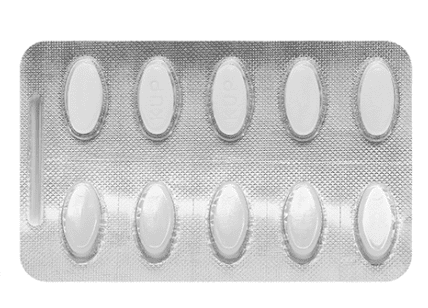This is an automatically translated article.
Galcholic medicine 200mg is a medicine specializing in the treatment of primary biliary cirrhosis, sclerosing cholangitis, cholesterol stones in the gallbladder... The drug is prepared in the form of film-coated tablets and is taken orally. Please refer to the article below for more information about the use of this drug.
1. What does Galcholic 200mg do?
Galcholic medicine has the main ingredient is 200mg Ursodeoxycholic Acid and excipients just enough. With this active ingredient, Galcholic 200mg is indicated for use in cases such as:
Cholesterol stones in the gallbladder: Small gallstones (<15mm in diameter) or asymptomatic, without contrast. The gallbladder is still functioning normally and surgery is contraindicated; Chronic liver and biliary diseases: Especially sclerosing cholangitis, primary biliary cirrhosis, liver disease caused by viscous mucus disease. Treatment of cystic fibrosis in children aged 6 to 18 years. Galcholic 200mg is contraindicated in the following subjects:
Allergy to ursodeoxycholic acid or to any of its ingredients Complete blockage of the bile duct (the choleretic effect can aggravate symptoms); Contrast calcified gallstones are present; People with acute inflammation of the gallbladder or with poor contraction of the biliary tract/gall bladder; Frequent occurrence of biliary colic; Suffering from acute peptic ulcer; Colitis or inflammatory bowel disease such as Crohn's disease. Have liver or bowel problems that interfere with the flow of bile, such as: bile duct obstruction, intrahepatic cholestasis, extrahepatic cholestasis, surgery to remove part of the small intestine; Patients with acute, chronic hepatitis or severe liver disease; Women who are pregnant or suspected of being pregnant; Children who have undergone laparoscopic surgery have failed or failed to restore good bile flow in children with cholangitis.
2. Instructions on how to take Galcholic
Galcholic medicine 200mg is taken orally, taken after meals. The dose of the drug should be adjusted according to the type and severity of the disease. Example:
2.1. Treatment of primary biliary cirrhosis For adults and the elderly: Take 10-15mg/kg/day, divided into 2-4 times to drink; For children: Cholesterol stones in the bile and primary biliary cirrhosis are rare. If a dose of Galcholic occurs, the dose is calculated by body weight. It is necessary to consult a doctor when using drugs to treat this group of subjects. 2.2. Support for dissolution of cholesterol stones For adults and the elderly: Take 8-10mg/kg/day, divided into 2 oral doses or take a single dose in the evening. Particularly for obese patients, the dose can be increased to 15mg/kg/day and the duration of treatment can be extended up to 2 years, depending on the stone size and should be maintained for 3 months after the stone has dissolved.
2.2. Treatment of cystic fibrosis for children For children with cystic fibrosis from 6-16 years old, it is necessary to take 20mg/kg/day divided into 2-3 times. If necessary, the dose can be increased to 30 mg/kg/day.
3. Side effects of the drug Galcholic
Overall, Galcholic was well tolerated, with almost no significant changes in liver function. However, users may still experience some side effects according to the degree as follows:
Common side effects: Gastrointestinal disorders such as diarrhea, pasty stools; Rare side effects: Abdominal pain, constipation, epigastric pain, heartburn; rash, urticaria; dizziness, generalized malaise, leukopenia, increased serum bilirubin. Very rare side effects: Calcified gallstones, skin rashes.
4. Notes when using Galcholic
During the first 3 months of treatment with Galcholic, it is necessary to monitor liver function parameters AST (SGOT), ALT (SGPT) and γ-GT every 4 weeks, and then maintain every 3 months; When using Galcholic to dissolve cholesterol gallstones, in order to evaluate the effectiveness of treatment and timely detect the calcification status of gallstones, it is necessary to take a contrast-enhanced cholecystogram (oral) after 6 - 10 months of treatment; If diarrhea occurs during administration, the dose of Galcholic should be reduced, and in case of persistent diarrhea, the drug should be discontinued; Diets high in calories and cholesterol should be avoided. It is recommended that patients adhere to a low-cholesterol diet to support the therapeutic effect of the drug; Galcholic contains lactose, so patients with rare hereditary problems of galactose intolerance, the Lapp lactase deficiency or glucose-galactose malabsorption should not take this medicine.
5. Galcholic drug interactions
Because of the active ingredient ursodeoxycholic acid, Galcholic should not be used concurrently with the following preparations:
Colestipol, Cholestyramine or antacids containing aluminum hydroxide and/or smectite (aluminum oxide) because these preparations bind ursodeoxycholic acid. in the intestine and inhibit its absorption and utilization. If used, it must be at least 2 hours before or after ursodeoxycholic acid; Ciclosporin because ursodeoxycholic acid increases the absorption of ciclosporin in the intestine. For patients being treated with ciclosporin, blood levels of this substance should be regularly checked and the dose of ciclosporin should be adjusted if necessary; Ciprofloxacin because ursodeoxycholic acid may decrease the absorption of this medicine; Nitendipine as Ursodeoxycholic Acid also reduces the maximum plasma concentration (Cmax) and area under the curve (AUC) of this drug; Dapson because ursodeoxycholic acid may decrease the therapeutic effect of this medicine. In addition, oral contraceptives, estrogen and clofibrat hormones can also increase gallstones, while the active ingredient ursodeoxycholic acid in Galcholic is used to dissolve gallstones.
Please dial HOTLINE for more information or register for an appointment HERE. Download MyVinmec app to make appointments faster and to manage your bookings easily.













